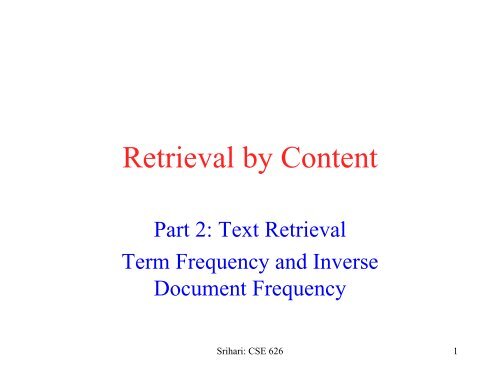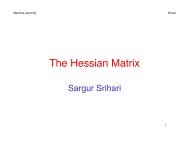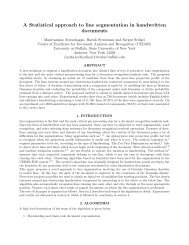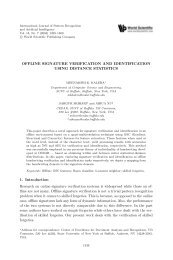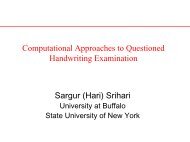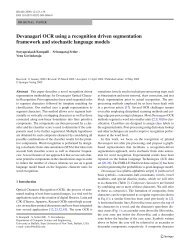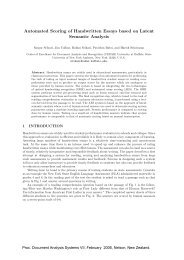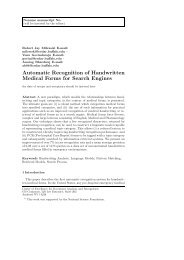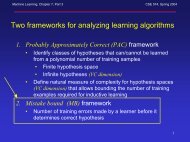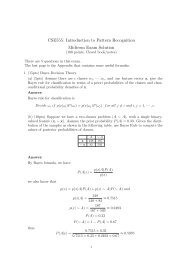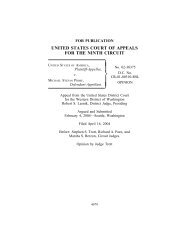Text Retrieval: Term Frequency and Inverse Document ... - CEDAR
Text Retrieval: Term Frequency and Inverse Document ... - CEDAR
Text Retrieval: Term Frequency and Inverse Document ... - CEDAR
You also want an ePaper? Increase the reach of your titles
YUMPU automatically turns print PDFs into web optimized ePapers that Google loves.
<strong>Retrieval</strong> by Content<br />
Part 2: <strong>Text</strong> <strong>Retrieval</strong><br />
<strong>Term</strong> <strong>Frequency</strong> <strong>and</strong> <strong>Inverse</strong><br />
<strong>Document</strong> <strong>Frequency</strong><br />
Srihari: CSE 626 1
<strong>Text</strong> <strong>Retrieval</strong><br />
• <strong>Retrieval</strong> of text-based information is referred to<br />
as Information <strong>Retrieval</strong> (IR)<br />
• Used by text search engines over the internet<br />
• <strong>Text</strong> is composed of two fundamental units<br />
documents <strong>and</strong> terms<br />
• <strong>Document</strong>: journal paper, book, e-mail messages,<br />
source code, web pages<br />
• <strong>Term</strong>: word, word-pair, phrase within a document<br />
Srihari: CSE 626 2
Representation of <strong>Text</strong><br />
• Capability to retain as much of the semantic<br />
content of the data as possible<br />
• Computation of distance measures between<br />
queries <strong>and</strong> documents efficiently<br />
• Natural language processing is difficult, e.g.,<br />
– Polysemy (same word with different meanings)<br />
– Synonymy (several different ways to describe the same<br />
thing)<br />
• IR systems is use today do not rely on NLP<br />
techniques<br />
– Instead rely on vector of term occurrences<br />
Srihari: CSE 626 3
Vector Space Representation<br />
<strong>Document</strong>-<strong>Term</strong> Matrix<br />
t1 t2 t3 t4 t5 t6<br />
D1 24 21 9 0 0 3<br />
D2 32 10 5 0 3 0<br />
D3 12 16 5 0 0 0<br />
D4 6 7 2 0 0 0<br />
D5 43 31 20 0 3 0<br />
D6 2 0 0 18 7 16<br />
D7 0 0 1 32 12 0<br />
D8 3 0 0 22 4 2<br />
D9 1 0 0 34 27 25<br />
D10 6 0 0 17 4 23<br />
<strong>Term</strong>s used<br />
In “Database”<br />
Related<br />
t1<br />
t2<br />
t3<br />
t4<br />
t5<br />
t6<br />
database<br />
SQL<br />
index<br />
regression<br />
likelihood<br />
linear<br />
“Regression” <strong>Term</strong>s<br />
d ij represents number of times<br />
that term appears in that document<br />
Srihari: CSE 626 4
Cosine Distance between <strong>Document</strong> Vectors<br />
<strong>Document</strong>-<strong>Term</strong> Matrix<br />
t1 t2 t3 t4 t5 t6<br />
D1 24 21 9 0 0 3<br />
D2 32 10 5 0 3 0<br />
D3 12 16 5 0 0 0<br />
D4 6 7 2 0 0 0<br />
D5 43 31 20 0 3 0<br />
D6 2 0 0 18 7 16<br />
D7 0 0 1 32 12 0<br />
D8 3 0 0 22 4 2<br />
D9 1 0 0 34 27 25<br />
D10 6 0 0 17 4 23<br />
d<br />
c<br />
Cosine Distance<br />
( D , D<br />
i<br />
j<br />
) =<br />
T<br />
∑<br />
k = 1<br />
d<br />
ik<br />
d<br />
jk<br />
T T<br />
2<br />
∑dik<br />
∑<br />
k = 1 k = 1<br />
Cosine of the angle between two vectors<br />
Equivalent to their inner product after each has been normalized to have unit<br />
Higher values for more similar vectors<br />
Reflects similarity in terms of relative distributions of components<br />
d<br />
2<br />
jk<br />
Cosine is not influenced by one document being small compared<br />
Srihari: CSE 626 5<br />
to the other (as in the case of Euclidean)
Euclidean vs Cosine Distance<br />
Database<br />
Regression<br />
<strong>Document</strong>-<strong>Term</strong> Matrix<br />
t1 t2 t3 t4 t5 t6<br />
D1 24 21 9 0 0 3<br />
D2 32 10 5 0 3 0<br />
D3 12 16 5 0 0 0<br />
D4 6 7 2 0 0 0<br />
D5 43 31 20 0 3 0<br />
D6 2 0 0 18 7 16<br />
D7 0 0 1 32 12 0<br />
D8 3 0 0 22 4 2<br />
D9 1 0 0 34 27 25<br />
D10 6 0 0 17 4 23<br />
<strong>Document</strong><br />
<strong>Document</strong><br />
Euclidean<br />
White = 0<br />
Black =<br />
max distance<br />
<strong>Document</strong> Number<br />
Cosine<br />
White =<br />
LargerCosine<br />
(or smaller angle)<br />
Both show two clusters of light sub-blocks<br />
<strong>Document</strong><br />
(database documents <strong>and</strong> regression documents)<br />
Euclidean: 3,4 closer to 6-9 than to 5 since 3,4, 6-9 are closer to origin than 5<br />
Cosine emphasizes relative contributions of individual terms<br />
Srihari: CSE 626 6
Properties of <strong>Document</strong>-<strong>Term</strong> Matrix<br />
• Each vector D i is a surrogate document for the original<br />
document<br />
• Entire document-term matrix (N x T) is sparse, with only<br />
0.03% of cells being non-zero in TREC collection<br />
• Each document is a vector in terms-space<br />
• Due to sparsity, original text documents are represented as<br />
an inverted file structure (rather than matrix directly)<br />
– Each term t j points to a list of N numbers describing term<br />
occurrences for each document<br />
• Generating document-term matix is non-trivial<br />
– Are plural <strong>and</strong> singular terms counted<br />
– Are very common words used as terms<br />
Srihari: CSE 626 7
Vector Space Representation of Queries<br />
• Queries<br />
– Expressed using same term-based representation as<br />
documents<br />
– Query is a document with very few terms<br />
• Vector space representation of queries<br />
t1<br />
– database = (1,0,0,0,0,0)<br />
t2<br />
– SQL = (0,1,0,0,0,0)<br />
t3<br />
– regression = (0,0,0,1,0,0)<br />
t4<br />
<strong>Term</strong>s<br />
database<br />
SQL<br />
index<br />
regression<br />
t5<br />
t6<br />
likelihood<br />
linear<br />
Srihari: CSE 626 8
Query match against database using<br />
cosine distance<br />
database SQL index regression likelihood linear<br />
D1 24 21 9 0 0 3<br />
D2 32 10 5 0 3 0<br />
D3 12 16 5 0 0 0<br />
D4 6 7 2 0 0 0<br />
D5 43 31 20 0 3 0<br />
D6 2 0 0 18 7 16<br />
D7 0 0 1 32 12 0<br />
D8 3 0 0 22 4 2<br />
D9 1 0 0 34 27 25<br />
D10 6 0 0 17 4 23<br />
database = (1,0,0,0,0,0) closest match is D2<br />
SQL = (0,1,0,0,0,0) closest match is D3<br />
regression = (0,0,0,1,0,0) <br />
closest match is D9<br />
Use of cosine distance results in D2, D3 <strong>and</strong> D9 ranked as closest<br />
Srihari: CSE 626 9
Weights in Vector Space Model<br />
• d ik is the weight for the k th term<br />
• Many different choices for weights in IR literature<br />
– Boolean approach of setting weights to 1 if term occurs<br />
<strong>and</strong> 0 if it doesn’t<br />
• favors larger documents since larger document is more likely<br />
to include query term somewhere<br />
– TF-IDF weighting scheme is popular<br />
• TF (term frequency) is same as seen earlier<br />
• IDF (inverse document frequency) favors terms that occur in<br />
relatively few documents<br />
database SQL index regression likelihood linear<br />
D1 24 21 9 0 0 3<br />
D2 32 10 5 0 3 0<br />
D3 12 16 5 0 0 0<br />
D4 6 7 2 0 0 0<br />
D5 43 31 20 0 3 0<br />
D6 2 0 0 18 7 16<br />
D7 0 0 1 32 12 0<br />
D8 3 0 0 22 4 2<br />
D9 1 0 0 34 27 25<br />
D10 6 0 0 17 4 23<br />
Srihari: CSE 626 10
<strong>Inverse</strong> <strong>Document</strong> <strong>Frequency</strong> of a <strong>Term</strong><br />
• Definition<br />
log( N<br />
N = total number of documents<br />
n j = number of documents containing term j<br />
( / N)<br />
is<br />
n j<br />
the fraction of<br />
/<br />
n<br />
j<br />
)<br />
documents containing term j<br />
• IDF favors terms that occur in relatively few documents<br />
• Example of IDF<br />
IDF weights of terms (using natural logs):<br />
0.105,0.693,0.511,0.693,0.357,0.69<br />
<strong>Term</strong> “database” occurs in many documents<br />
<strong>and</strong> is given least weight<br />
“regression” occurs in fewest documents <strong>and</strong><br />
given highest weight<br />
database SQL index regression likelihood linear<br />
D1 24 21 9 0 0 3<br />
D2 32 10 5 0 3 0<br />
D3 12 16 5 0 0 0<br />
D4 6 7 2 0 0 0<br />
D5 43 31 20 0 3 0<br />
D6 2 0 0 18 7 16<br />
D7 0 0 1 32 12 0<br />
D8 3 0 0 22 4 2<br />
D9 1 0 0 34 27 25<br />
Srihari: CSE 626 11<br />
D10 6 0 0 17 4 23
TF-IDF Weighting of <strong>Term</strong>s<br />
• TF-IDF weighting scheme<br />
• TF = term frequency, denoted TF(d,t)<br />
• IDF = inverse document frequency, IDF(t)<br />
• TF-IDF weight is the product of TF <strong>and</strong> IDF<br />
for a particular term in a particular document<br />
– TF(d,t)IDF(t)<br />
– Example is given next<br />
Srihari: CSE 626 12
TF-IDF <strong>Document</strong> Matrix<br />
TF (d,t) <strong>Document</strong> Matrix<br />
database SQL index regression likelihood linear<br />
D1 24 21 9 0 0 3<br />
D2 32 10 5 0 3 0<br />
D3 12 16 5 0 0 0<br />
D4 6 7 2 0 0 0<br />
D5 43 31 20 0 3 0<br />
D6 2 0 0 18 7 16<br />
D7 0 0 1 32 12 0<br />
D8 3 0 0 22 4 2<br />
D9 1 0 0 34 27 25<br />
D10 6 0 0 17 4 23<br />
IDF (t) weights (using natural logs):<br />
0.105,0.693,0.511,0.693,0.357,0.69<br />
TF-IDF <strong>Document</strong> Matrix<br />
2.53 14.56 4.6 0 0 2.07<br />
3.37 6.93 2.55 0 1.07 0<br />
1.26 11.09 2.55 0 0 0<br />
0.63 4.85 1.02 0 0 0<br />
4.53 21.48 10.21 0 1.07 0<br />
0.21 0 0 12.47 2.5 11.09<br />
0 0 0.51 22.18 4.28 0<br />
0.31 0 0 15.24 1.42 1.38<br />
0.1 0 0 23.56 9.63 17.33<br />
0.63 0 0 11.78 1.42 15.94<br />
Srihari: CSE 626 13
Classic Approach to Matching<br />
Queries to <strong>Document</strong>s<br />
• Represent queries as term vectors<br />
– 1s for terms occurring in the query <strong>and</strong> 0s everywhere<br />
else<br />
• Represent term vectors for documents using TF-<br />
IDF for the vector components<br />
• Use the cosine distance measure to rank the<br />
documents in terms of distance to query<br />
– Has disadvantage that shorter documents have a better<br />
match with query terms<br />
Srihari: CSE 626 14
<strong>Document</strong> <strong>Retrieval</strong> with TF <strong>and</strong> TF-IDF<br />
TF: <strong>Document</strong> <strong>Term</strong> Matrix<br />
database SQL index regression likelihood linear<br />
D1 24 21 9 0 0 3<br />
D2 32 10 5 0 3 0<br />
D3 12 16 5 0 0 0<br />
D4 6 7 2 0 0 0<br />
D5 43 31 20 0 3 0<br />
D6 2 0 0 18 7 16<br />
D7 0 0 1 32 12 0<br />
D8 3 0 0 22 4 2<br />
D9 1 0 0 34 27 25<br />
D10 6 0 0 17 4 23<br />
Query contains both database <strong>and</strong> index<br />
Q=(1,0,1,0,0,0)<br />
TF-IDF <strong>Document</strong> Matrix<br />
2.53 14.56 4.6 0 0 2.07<br />
3.37 6.93 2.55 0 1.07 0<br />
1.26 11.09 2.55 0 0 0<br />
0.63 4.85 1.02 0 0 0<br />
4.53 21.48 10.21 0 1.07 0<br />
0.21 0 0 12.47 2.5 11.09<br />
0 0 0.51 22.18 4.28 0<br />
0.31 0 0 15.24 1.42 1.38<br />
0.1 0 0 23.56 9.63 17.33<br />
0.63 0 0 11.78 1.42 15.94<br />
<strong>Document</strong> TF distance TF-IDF distance<br />
D1 0.7 0.32<br />
D2 0.77 0.51<br />
D3 0.58 0.24<br />
D4 0.6 0.23<br />
D5 0.79 0.43<br />
D6 0.14 0.02<br />
D7 0.06 0.01<br />
D8 0.02 0.02<br />
D9 0.09 0.01<br />
D10 0.01 0<br />
Max values for query (1,0,1,0,0,0)<br />
Cosine distance is high when there is a<br />
better match<br />
TF-IDF chooses D2 while TF chooses D5<br />
Unclear why D5 is a better choice<br />
Cosine distance favors shorter documents<br />
Srihari: CSE 626 15<br />
(a disadvantage)
Comments on TF-IDF Method<br />
• TF-IDF-based IR system<br />
– first builds an inverted index with TF <strong>and</strong> IDF information<br />
– Given a query (vector) lists some number of document<br />
vectors that are most similar to the query<br />
• TF-IDF is superior in precision-recall compared to<br />
other weighting schemes<br />
• Default baseline method for comparing performance<br />
Srihari: CSE 626 16


